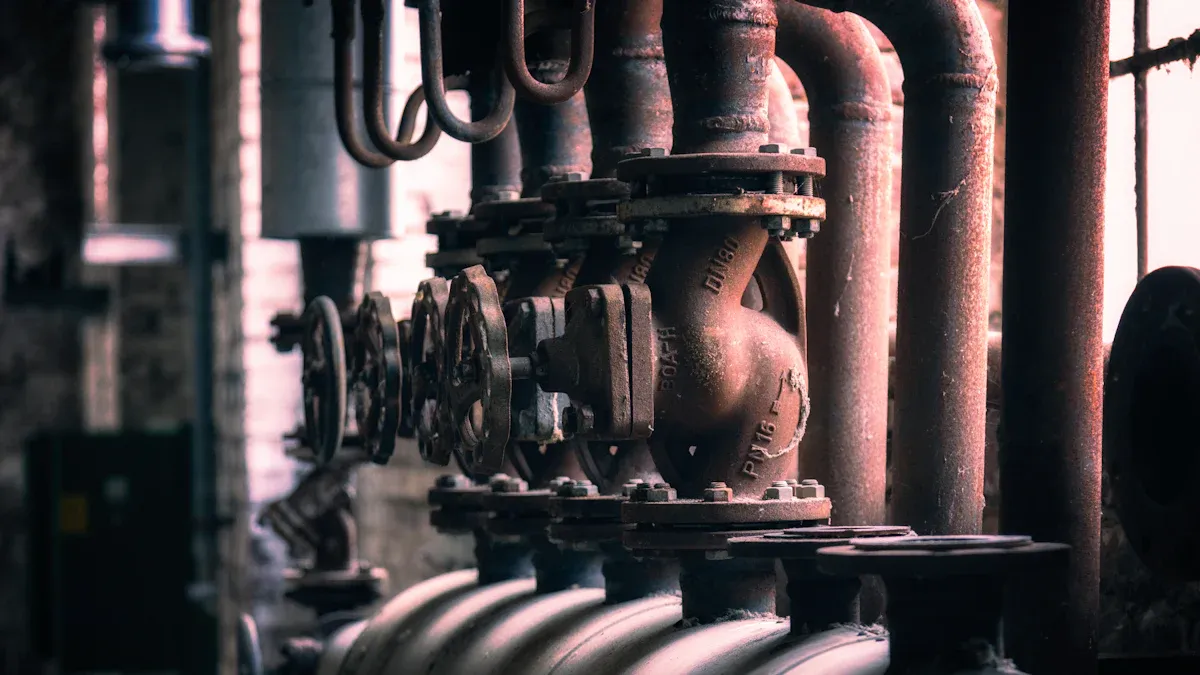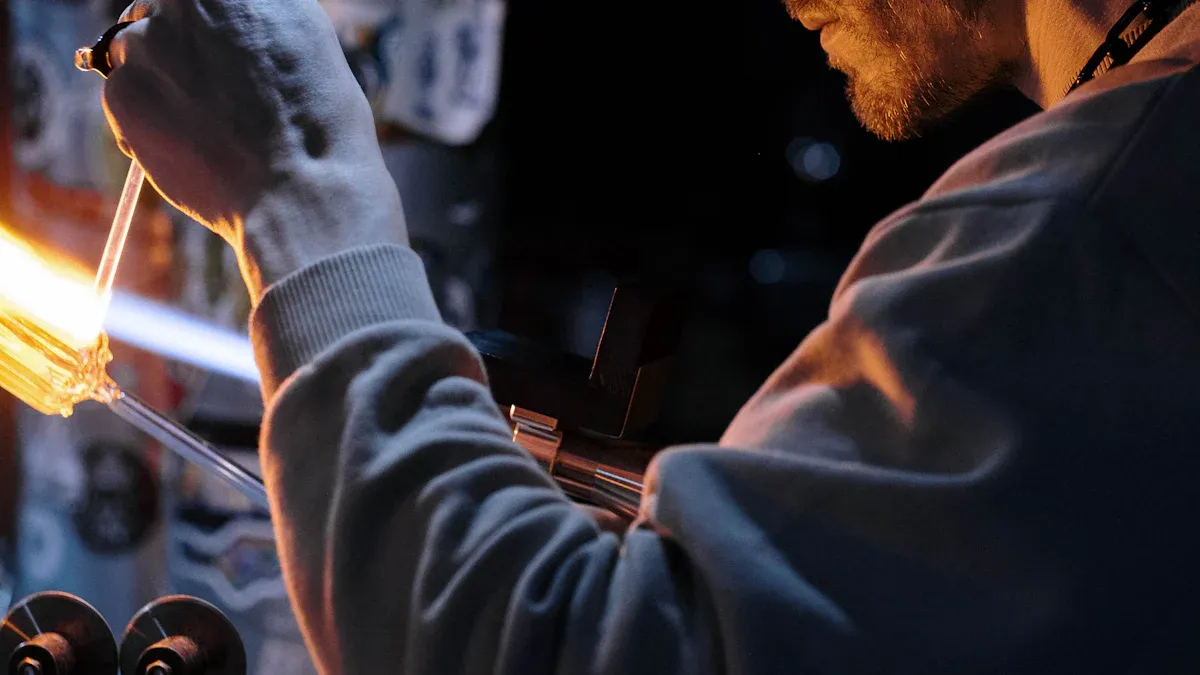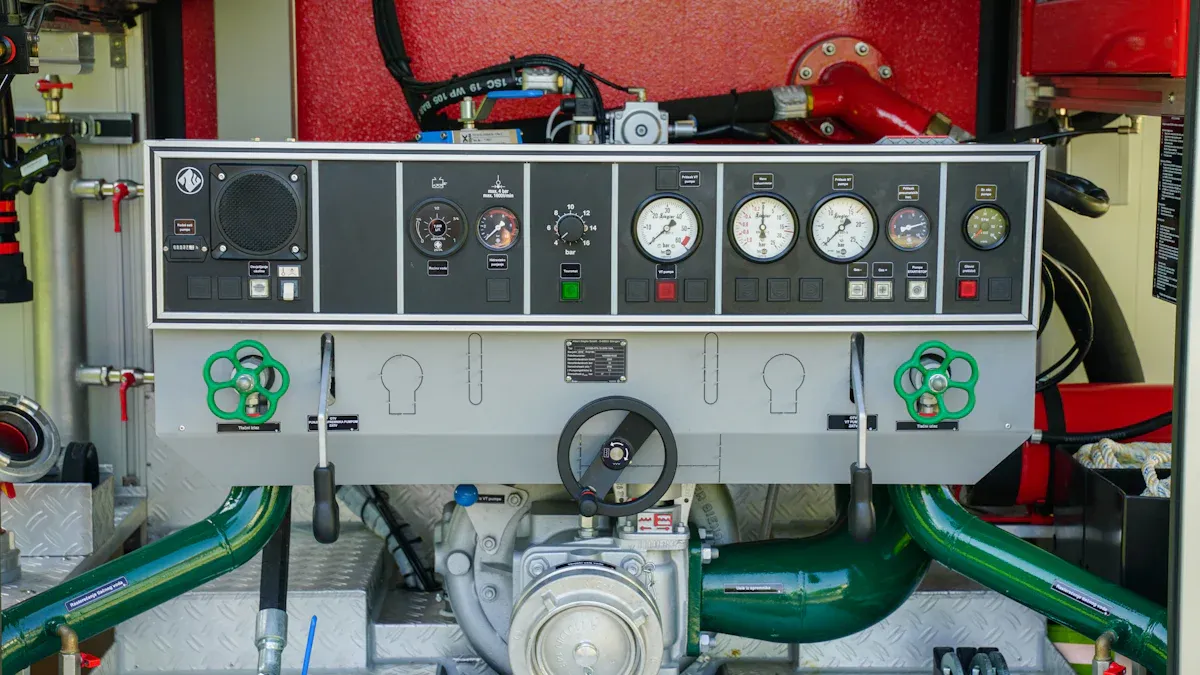
Automatic adjustment machines use advanced technology to create a perfect flame every time. These machines monitor and control flame size and intensity with precise feedback systems. Accurate flame control plays a crucial role in optimizing performance and ensuring safety in manufacturing environments. Industries such as lighter manufacturing rely on dependable flame quality to meet strict standards and maintain consistent product output.
Consistent flame control reduces risk and supports high production efficiency.
Key Takeaways
- Automatic adjustment machines use sensors and feedback systems to monitor and control flame size, color, and temperature in real time.
- Precise flame control improves safety by preventing accidents and ensures consistent product quality in industries like lighter manufacturing.
- Stable and clean flames reduce maintenance needs, lower fuel costs, and protect both equipment and the environment.
- These machines adapt quickly to changes in fuel quality and environmental conditions, keeping flames stable and efficient.
- Advanced control systems use machine learning and AI to predict and adjust flame settings for better performance and less manual work.
- Reliable actuators and valves respond instantly to control signals, maintaining the perfect flame and reducing human error.
- Automatic adjustment machines help factories meet strict safety and quality standards while increasing production speed and reducing waste.
- Future flame control technology will be smarter and more connected, using IoT and cloud systems to improve monitoring and maintenance.
Automatic Adjustment Machines: Achieving the Perfect Flame

Direct Mechanisms for Flame Perfection
Real-Time Monitoring and Adjustment
Automatic Adjustment Machines use advanced sensors to monitor flame characteristics in real time. These sensors detect variables such as flame height, color, and temperature. The machines collect this data continuously. When the system identifies any deviation from the desired flame parameters, it makes immediate adjustments. This process ensures that the flame remains stable and within set specifications.
Tip: Real-time monitoring helps maintain consistent product quality and reduces the risk of defects.
Feedback Loops and Control Systems
Feedback loops form the core of precise flame control. The system compares actual flame data with target values. If the flame strays from the ideal range, the control unit sends signals to actuators. These actuators adjust fuel or air flow to correct the flame. This closed-loop process repeats many times per second, creating a self-correcting mechanism.
A typical feedback loop in Automatic Adjustment Machines includes:
- Sensors that gather flame data
- A control unit that analyzes the data
- Actuators that make physical adjustments
This structure allows the machines to respond quickly to changes, ensuring the flame remains perfect throughout production.
Why Precision Matters
Performance Optimization
Precision in flame adjustment leads to optimal performance. Consistent flame size and temperature improve the efficiency of combustion. Products such as lighters require exact flame characteristics to function properly. Automatic Adjustment Machines help manufacturers achieve high production rates without sacrificing quality.
A table below shows the impact of precision on performance:
| Parameter | Without Precision | With Precision |
|---|---|---|
| Flame Stability | Low | High |
| Product Quality | Variable | Consistent |
| Production Speed | Slower | Faster |
Safety Assurance
Safety remains a top priority in any flame-based process. Precise flame control reduces the risk of accidents, such as flare-ups or incomplete combustion. Automatic Adjustment Machines detect unsafe conditions and correct them instantly. This proactive approach protects both operators and equipment.
Note: Reliable flame adjustment systems help companies comply with strict safety standards and regulations.
Defining the Perfect Flame
Characteristics of a Perfect Flame
Stability and Clean Combustion
A perfect flame demonstrates unwavering stability. The flame does not flicker or waver, even when environmental conditions change. Stability ensures that the combustion process remains predictable. Manufacturers rely on this predictability to maintain quality and safety.
Clean combustion stands as another hallmark of a perfect flame. Clean combustion produces minimal soot, smoke, or harmful byproducts. The process converts fuel into energy efficiently, leaving behind only water vapor and carbon dioxide. This quality protects both equipment and the environment.
Note: Stable and clean flames reduce maintenance needs and extend the lifespan of machinery.
Efficiency and Consistency
Efficiency defines how well a flame converts fuel into usable energy. A perfect flame uses the least amount of fuel to achieve the desired heat output. This efficiency lowers operational costs and supports sustainable practices.
Consistency means the flame maintains the same size, color, and temperature throughout production. Consistent flames ensure that every product meets the same high standards. Operators can trust the process to deliver uniform results, batch after batch.
A quick comparison highlights these traits:
| Characteristic | Benefit |
|---|---|
| Stability | Reliable operation |
| Clean Combustion | Less residue, safer process |
| Efficiency | Lower fuel costs |
| Consistency | Uniform product quality |
Application-Specific Flame Requirements
Lighter Manufacturing Standards
Lighter manufacturers set strict standards for flame quality. The flame must ignite quickly, burn steadily, and reach a precise height. These requirements guarantee user safety and product reliability. Automatic adjustment machines help factories meet these standards by monitoring and correcting the flame in real time.
Key requirements for lighter flames include:
- Height between 20mm and 30mm
- Blue or blue-yellow color, indicating complete combustion
- No visible smoke or soot
Tip: Meeting these standards helps manufacturers comply with international safety regulations.
Industrial and Laboratory Needs
Industrial and laboratory settings demand specialized flame characteristics. Laboratories often require a flame with a specific temperature for chemical reactions. Industries such as glassmaking or metalworking need flames that remain stable under varying conditions.
Some common needs in these environments:
- Precise temperature control for repeatable experiments
- Adjustable flame size for different materials
- Rapid response to environmental changes
Automatic adjustment machines provide the flexibility and precision needed for these demanding applications. They ensure that every flame meets the exact requirements of the task at hand.
The Science of Flame Creation
Fuel Types and Their Influence
Common Fuels in Flame Applications
Manufacturers select fuels based on the specific requirements of each application. The most common fuels include butane, propane, natural gas, and hydrogen. Each fuel offers unique properties that affect flame performance.
- Butane: Popular in lighters and portable devices. It vaporizes easily at room temperature.
- Propane: Used in industrial torches and laboratory burners. It provides a hotter flame than butane.
- Natural Gas: Common in large-scale heating and laboratory settings. It burns cleanly and efficiently.
- Hydrogen: Used in specialized scientific applications. It produces a nearly invisible, high-temperature flame.
Note: The choice of fuel impacts not only the flame’s appearance but also its temperature and stability.
Effects on Flame Behavior
Different fuels create distinct flame characteristics. Butane and propane produce blue flames, indicating efficient combustion. Natural gas also yields a blue flame, which signals a clean burn. Hydrogen flames appear almost invisible and reach higher temperatures.
A comparison table highlights these differences:
| Fuel Type | Flame Color | Typical Use | Max Temp (°C) |
|---|---|---|---|
| Butane | Blue | Lighters | 1,970 |
| Propane | Blue | Torches, Labs | 1,980 |
| Natural Gas | Blue | Heating, Labs | 1,960 |
| Hydrogen | Invisible | Scientific Research | 2,000+ |
Oxygen-to-Fuel Ratios
Achieving Stoichiometric Balance
A perfect flame requires the right mix of fuel and oxygen. This balance is called the stoichiometric ratio. When the ratio is correct, the flame burns cleanly and efficiently. Sensors in automatic adjustment machines measure both fuel and oxygen levels. The control system then adjusts the flow to maintain this ideal ratio.
Tip: Maintaining the stoichiometric balance ensures complete combustion and reduces emissions.
Consequences of Imbalance
An incorrect oxygen-to-fuel ratio leads to problems. Too much fuel causes a yellow, sooty flame. Too much oxygen creates a noisy, unstable flame. Both conditions reduce efficiency and can damage equipment.
- Fuel-rich flame: Produces soot, wastes fuel, and lowers temperature.
- Oxygen-rich flame: Increases wear on components and may cause safety risks.
Temperature Control in Combustion
Measuring and Maintaining Flame Temperature
Precise temperature control is essential for consistent product quality. Sensors such as thermocouples and infrared detectors measure flame temperature in real time. The control unit uses this data to adjust fuel and air flow, keeping the temperature within the desired range.
Importance for Product Quality
Stable flame temperature ensures uniform heating. In lighter manufacturing, this consistency guarantees that each product meets strict standards. In laboratories, accurate temperature control supports reliable experimental results.
Consistent temperature control leads to higher efficiency, better safety, and superior product quality.
How Automatic Adjustment Machines Work
Sensor Technologies in Flame Adjustment
Infrared and Flame Sensors
Infrared sensors play a vital role in detecting flame presence and characteristics. These sensors measure the heat energy emitted by the flame. They provide instant feedback about flame temperature and stability. Flame sensors, often using photodiodes or ultraviolet detectors, identify the flame’s color and intensity. This information helps the system determine if the combustion process remains within the desired range.
Note: Infrared and flame sensors allow machines to react quickly to any changes in flame behavior, ensuring consistent quality.
Gas Flow and Pressure Sensors
Gas flow sensors monitor the amount of fuel entering the combustion chamber. Pressure sensors track the force of gas moving through the system. Together, these sensors help maintain the correct fuel-to-oxygen ratio. If the sensors detect a drop or spike in flow or pressure, the system can adjust the valves immediately. This rapid response prevents unsafe conditions and supports efficient operation.
Feedback and Control Algorithms
Closed-Loop and Open-Loop Systems
Closed-loop systems use continuous feedback from sensors to make real-time adjustments. The system compares actual flame data to target values and corrects any deviations. Open-loop systems, on the other hand, operate based on preset parameters without feedback. Most modern Automatic Adjustment Machines rely on closed-loop control for higher accuracy and safety.
| System Type | Feedback Used | Adjustment Method | Typical Use Case |
|---|---|---|---|
| Closed-Loop | Yes | Real-Time | Lighter manufacturing |
| Open-Loop | No | Preset | Simple heating devices |
Adaptive and Predictive Adjustments
Advanced machines use adaptive algorithms to learn from previous operations. These algorithms adjust settings based on changing conditions, such as fuel quality or ambient temperature. Predictive adjustments use data trends to anticipate changes before they occur. This proactive approach ensures the flame remains stable, even when external factors shift.
Actuators and Regulation Mechanisms
Fuel and Oxygen Flow Control
Actuators serve as the hands of the system. They open or close valves to regulate the flow of fuel and oxygen. By responding to sensor data, actuators keep the flame at the correct size and temperature. This precise control supports both safety and efficiency.
Electronic and Mechanical Adjustments
Some machines use electronic actuators for fast, accurate adjustments. Others rely on mechanical systems, such as springs or gears, for robust performance. Both types ensure the system can respond to sensor input and maintain optimal flame conditions.
Tip: Reliable actuators and regulation mechanisms help maintain high repeatability in industrial production.
Key Components of Automatic Adjustment Machines

Sensors and Detectors
Monitoring Flame Characteristics
Sensors and detectors form the foundation of precise flame control. These devices measure critical aspects such as flame height, color, and temperature. Engineers select sensors based on the specific requirements of the application. For example, infrared sensors detect heat energy, while photodiodes capture visible light from the flame. By collecting this data, the system can identify even minor deviations from the desired flame profile.
Accurate monitoring ensures that every flame meets strict quality standards.
Detecting Environmental Changes
Environmental factors can influence flame behavior. Sensors track variables like ambient temperature, humidity, and air pressure. When these conditions shift, the system receives immediate feedback. This information allows the machine to adjust settings and maintain optimal performance. In industrial environments, rapid detection of environmental changes helps prevent inconsistencies and supports safe operation.
Central Processing and Control Units
Data Processing and Decision Making
The central processing unit acts as the brain of the machine. It receives data from all sensors and analyzes it in real time. The processor compares current flame characteristics to target values. When it detects a difference, it sends commands to actuators for correction. This process happens continuously, ensuring the flame remains stable and efficient.
A typical data flow in Automatic Adjustment Machines:
- Sensors collect flame and environmental data.
- The processor analyzes the data.
- The system makes decisions and sends instructions to actuators.
Integration with Machine Learning
Modern machines often include machine learning capabilities. These systems learn from historical data and improve their decision-making over time. By recognizing patterns, the processor can predict changes and adjust settings before problems arise. This adaptive approach leads to higher consistency and better product quality.
Machine learning integration allows the system to optimize itself for different production scenarios.
Actuators and Valves
Adjusting Gas and Air Supply
Actuators and valves control the flow of gas and air to the combustion chamber. When the processor sends a command, actuators respond by opening or closing valves. This action changes the amount of fuel or oxygen reaching the flame. Quick and precise adjustments help maintain the ideal flame size and temperature.
| Component | Function |
|---|---|
| Actuator | Moves valves based on signals |
| Valve | Regulates gas or air flow |
Ensuring Responsive Operation
Responsiveness is essential for maintaining a perfect flame. High-quality actuators react instantly to processor commands. This rapid response minimizes delays and prevents fluctuations in flame characteristics. Reliable operation supports both safety and efficiency in production environments.
Responsive actuators and valves help maintain high repeatability and reduce the risk of human error.
Overcoming Challenges in Flame Adjustment
Variability in Fuel and Environmental Conditions
Detecting and Compensating for Inconsistencies
Automatic adjustment machines face constant changes in fuel quality and environmental factors. Sensors play a critical role in identifying these inconsistencies. They monitor variables such as gas purity, ambient temperature, and humidity. When the system detects a deviation, it responds by recalibrating the fuel-to-oxygen ratio or adjusting the flame size. This rapid compensation ensures the flame remains stable and efficient.
Tip: Continuous monitoring helps prevent unexpected fluctuations that could impact product quality or safety.
Automated Adaptation to Changes
Modern machines use adaptive algorithms to handle shifting conditions. These algorithms analyze sensor data and adjust settings in real time. For example, if the ambient temperature rises, the system may reduce fuel flow to maintain the correct flame temperature. This automated adaptation minimizes manual intervention and keeps production running smoothly.
A simple process flow:
- Sensors detect a change.
- The control unit processes the data.
- The system makes precise adjustments.
Wear and Maintenance of Machine Components
Predictive Maintenance Strategies
Mechanical parts in adjustment machines experience wear over time. Predictive maintenance strategies use data from sensors to forecast when a component may need attention. The system tracks usage patterns, vibration, and temperature. When it identifies early signs of wear, it schedules maintenance before a breakdown occurs.
| Maintenance Type | Approach | Benefit |
|---|---|---|
| Reactive | After failure | Unplanned downtime |
| Preventive | Scheduled intervals | May replace too early |
| Predictive | Based on real data | Maximizes uptime |
Ensuring Long-Term Reliability
Long-term reliability depends on regular maintenance and high-quality components. Automatic adjustment machines often feature self-diagnostic tools. These tools alert operators to potential issues before they escalate. By addressing problems early, manufacturers extend the lifespan of their equipment and maintain consistent performance.
Note: Reliable machines reduce production interruptions and support continuous operation.
Ensuring Consistency Across Production
High Repeatability in Industrial Settings
Industrial production demands high repeatability. Automatic adjustment machines deliver consistent results by using precise sensors and control systems. Each unit produced meets the same standards, regardless of external changes. This repeatability supports large-scale manufacturing and helps companies meet strict quality requirements.
Minimizing Human Error
Automation reduces the risk of mistakes caused by manual adjustments. Machines follow programmed protocols and respond instantly to sensor feedback. Operators oversee the process but do not need to intervene frequently. This approach minimizes human error and ensures every product meets exact specifications.
Consistent automation leads to higher product quality and greater efficiency across the production line.
Real-World Benefits of Automatic Adjustment Machines
Enhanced Safety in Flame-Based Equipment
Accident Prevention and Risk Reduction
Automatic Adjustment Machines play a crucial role in preventing accidents in flame-based equipment. These machines monitor flame characteristics continuously and respond instantly to any irregularities. Sensors detect unsafe conditions, such as abnormal flame size or color, and trigger immediate corrections. Operators benefit from reduced risk of flare-ups, gas leaks, or incomplete combustion. This proactive safety approach protects both personnel and equipment.
Safety systems powered by real-time monitoring help companies avoid costly incidents and downtime.
Compliance with Safety Standards
Manufacturers must meet strict safety regulations in industries that use open flames. Automatic Adjustment Machines support compliance by maintaining precise control over combustion processes. These machines ensure that every product meets international safety standards. Auditors and inspectors can verify consistent flame quality, which simplifies certification and approval processes.
Improved Efficiency and Product Consistency
Reducing Material Waste
Efficient flame control leads to significant reductions in material waste. When machines maintain optimal combustion, fuel consumption decreases. Less fuel waste translates to lower operating costs and a smaller environmental footprint. Factories can also minimize the number of defective products, as consistent flames reduce the likelihood of errors during production.
Ensuring Uniform Output
Uniformity in production remains essential for brand reputation and customer satisfaction. Automatic Adjustment Machines deliver consistent flame characteristics for every unit produced. This repeatability ensures that each lighter or flame-based product performs as expected. Manufacturers can rely on these machines to produce large quantities with minimal variation.
| Benefit | Impact on Production |
|---|---|
| Reduced Waste | Lower costs, less rework |
| Uniform Output | Higher product reliability |
| Enhanced Efficiency | Faster production cycles |
Case Study: Ningbo Jiuqi Technology Co., Ltd.
Innovations in Lighter Manufacturing
Ningbo Jiuqi Technology Co., Ltd. has led the way in developing advanced equipment for the lighter industry since 2002. The company invests in independent research and design to create machines that offer high production efficiency and stable performance. Under the leadership of General Manager Mr. Chen Zhiming, the company has focused on solutions that are easy to operate, adjust, and maintain.
Impact on Global Lighter Factories
Factories worldwide have adopted Ningbo Jiuqi’s innovations to improve their manufacturing processes. These solutions provide high repeatability and reliability, which helps global lighter factories achieve consistent quality and output. The company’s commitment to professional service and technological advancement continues to shape the future of flame adjustment in the industry.
The Future of Automatic Adjustment Machines
Advances in Sensor and Control Technology
Higher Precision and Sensitivity
Sensor technology continues to evolve rapidly. Modern sensors now detect even the smallest changes in flame characteristics. These improvements allow machines to maintain tighter control over combustion. High-precision sensors measure temperature, gas flow, and flame color with remarkable accuracy. As a result, manufacturers achieve greater consistency and reduce the risk of defects.
Integration with IoT and Smart Systems
The integration of Internet of Things (IoT) technology transforms flame adjustment. Machines now connect to centralized monitoring systems. Operators receive real-time alerts and performance data on their devices. Smart systems enable remote diagnostics and adjustments. This connectivity streamlines maintenance and supports predictive analytics.
IoT integration helps companies optimize production and respond quickly to any issues.
Artificial Intelligence and Machine Learning
Predictive and Adaptive Flame Control
Artificial intelligence (AI) brings a new level of intelligence to flame control. AI algorithms analyze historical data and predict future trends. Machines adjust settings before problems occur. Adaptive control systems learn from each production cycle. They fine-tune parameters to match changing conditions, such as fuel quality or ambient temperature.
Self-Optimizing Systems
Self-optimizing systems represent the next step in automation. These systems use machine learning to improve performance over time. They identify patterns in sensor data and make continuous adjustments. Operators benefit from reduced manual intervention and higher efficiency. Self-optimization ensures that every flame meets strict quality standards.
| Benefit | Description |
|---|---|
| Predictive Control | Anticipates changes in real time |
| Adaptive Adjustment | Learns from ongoing operations |
| Self-Optimization | Continuously improves performance |
Expanding Applications Beyond Lighter Manufacturing
New Industrial and Scientific Uses
Flame adjustment technology now finds applications in many industries. Laboratories use advanced systems for precise chemical analysis. The food industry relies on controlled flames for consistent cooking and sterilization. Glass and metal manufacturers depend on stable flames for shaping and processing materials.
Emerging Trends in Flame Technology
Several trends shape the future of flame technology. Miniaturized sensors enable compact designs for portable devices. Energy-efficient components reduce operational costs. Integration with cloud-based platforms supports data-driven decision-making. These trends drive innovation and open new possibilities for flame-based equipment.
The future promises smarter, safer, and more versatile flame control solutions.
Automatic adjustment machines deliver the perfect flame through real-time monitoring, precise control, and adaptive technology. These systems offer unmatched safety, efficiency, and consistency in flame-based industries. Ongoing innovation drives improvements in sensor accuracy and smart automation.
Ningbo Jiuqi Technology Co., Ltd. stands at the forefront of this progress, providing advanced solutions that shape the future of flame control worldwide.
- Key benefits:
- Enhanced safety
- Reliable efficiency
- Consistent product quality
FAQ
What is an automatic adjustment machine?
An automatic adjustment machine uses sensors and control systems to monitor and regulate flame characteristics. The machine ensures consistent flame quality, safety, and efficiency in manufacturing environments.
How do sensors improve flame control?
Sensors detect changes in flame height, color, and temperature. The system uses this data to make real-time adjustments. This process maintains optimal combustion and product quality.
Why is precise flame adjustment important in lighter manufacturing?
Precise flame adjustment guarantees every lighter meets strict safety and performance standards. Manufacturers achieve uniform product quality and reduce the risk of defects.
Can automatic adjustment machines adapt to different fuels?
Yes. These machines use adaptive algorithms to recognize fuel type and quality. The system adjusts combustion parameters to maintain a stable and efficient flame.
What maintenance do automatic adjustment machines require?
Regular inspection and cleaning of sensors and actuators ensure reliable operation. Predictive maintenance features help identify issues before they cause downtime.
How do these machines enhance workplace safety?
Automatic adjustment machines detect unsafe flame conditions instantly. The system corrects problems before accidents occur. This proactive approach protects workers and equipment.
Are automatic adjustment machines suitable for industries beyond lighter manufacturing?
Absolutely. Industries such as laboratories, food processing, and metalworking benefit from precise flame control. The technology adapts to various applications requiring consistent combustion.
What role does Ningbo Jiuqi Technology Co., Ltd. play in this field?
Ningbo Jiuqi Technology Co., Ltd. leads innovation in automatic adjustment machines. The company provides advanced solutions for global lighter factories, focusing on efficiency, reliability, and ease of use.

